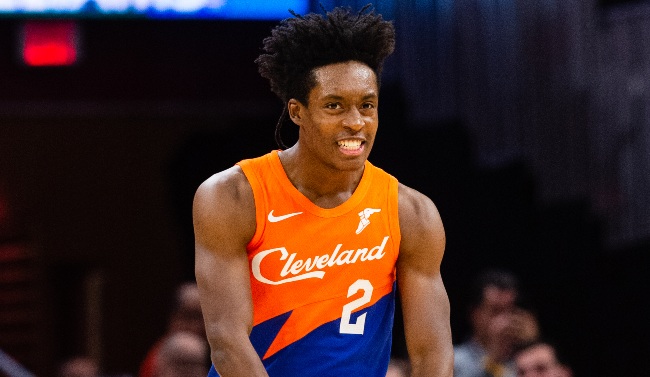
Early returns on Collin Sexton’s rookie year were not good. The worries draftniks had about him at the college level all reared their ugly heads at the same time – he flashed very little traditional point guard skill and was shooting an abysmal 41 percent from the field through his first 10 games. To make matters worse, he wasn’t bringing any value on the defensive end, where he was constantly getting lost and wasn’t able to affect opposing guards in the same manner he did during his lone season at Alabama.
Since then, things have gotten incrementally better — he’s up to 45 percent for the year and is even hitting his threes at a nearly 42 percent clip, though he doesn’t take enough to really make a difference from beyond the arc. The defense has also improved somewhat, though it’s fair to wonder whether it could have gotten much worse than it was. Sexton’s still a negative for a Cavaliers team that is chock full of negativity right now, but there are noticeable improvements in key areas.
As with many point guards across today’s NBA, Sexton’s offensive value will be driven by his outside jumper. His three-pointer doesn’t look awful when he takes it and he’s hitting them at a great clip, but he just doesn’t take enough of them for it to matter, nor do defenses fear that he can consistently knock them down. He’s chucked just 2.9 threes per 100 possessions so far this season, a mark that puts him firmly among the league’s non-shooters at the point guard spot.
Opposing teams are standing firm in their decision to duck under ball screens whenever possible, which helps to dissuade him from getting to his spots in mid-range and at the basket. There are positive indicators that he’ll put it together as an efficient shooter, though, as he’s already proficient as a mid-range assassin and has hit his free throws at both the college and pro level. Sexton loves the mid-range, where he takes a full 44 percent of his shots, the most in the league for any point guard, per Cleaning the Glass.
Another 44 percent of his shots are short floaters or at the basket, where he’s a below-average finisher. Those of you who are strong in math can put those numbers together and figure out just how few threes Sexton is getting up, despite his blistering percentage from outside. Turning some of those mid-rangers into threes would greatly impact his offensive value, as teams would have to start respecting him from those distances, but that progression is easier said than done and may take a year or two before tangible results take hold.
Unlocking the secrets of the three-point shot would help Sexton everywhere else, as well. Already a subpar passer for a point guard, things aren’t made any easier by the fact that teams don’t respect his outside shot or finishing ability, leading to defenses staying home on shooters. There’s very little panic instilled in opposing teams when Sexton is able to turn the corner in pick-and-roll. Even though he’s hitting the mid-ranger better than 64 percent of his counterparts at the point guard position, that’s still an inefficient shot compared to a catch-and-shoot three-pointer for one of his teammates.
It will take a ton of work for Sexton to improve as a distributor, and he lacks the natural feel for the game possessed by elite floor generals, so it’ll be important for him to maximize his scoring if he is to continue as Cleveland’s primary ball handler. If the pull-up three never quite gets there, Sexton should still be able to get to a positive place as a catch-and-shoot threat, though his ceiling in that role is relatively limited.
Defensively, the tools are there for Sexton to be great, but the mental side of things has come along slower than many (including myself) thought it would. The hard-nosed effort he showed at Alabama is still there, but it manifests itself more along the lines of watching a headless chicken run full speed into a wall than a sheepdog corralling opposing guards into bad shots.
As with his offense, he has improved on that end since the beginning of the season. Rotations are becoming crisper as he recognizes passes a beat ahead of where he was even just a month ago. His length serves him well when he switches onto bigger players, as does his bulldog mentality. It’ll take more than physical tools and effort to get him where he needs to be defensively, but there are signs that things are getting better there. Of course, just because things are improving doesn’t mean that they’re all the way there, as he showed on Tuesday against Minnesota, when a baffling rotation left Karl-Anthony Towns wide open.
Interesting defensive wrinkle by the Cavs here. pic.twitter.com/4Tt1lv9q6H
— Mike Prada. (PRAY-duh) (@MikePradaNBA) November 27, 2018
Making a final judgment on a rookie point guard six weeks into their career is a fool’s errand. All rookies improve on a nearly nightly basis, but point guards in particular take more time than other positions to grasp the complexities of the NBA game. Navigating pick-and-roll on both ends of the court takes many players years of practice and thousands of repetitions to get right, so expecting Sexton to already be at a high level on either end just isn’t realistic.
Still, progression is important, even in what looks to be a lost season for the Cavaliers from a win-loss perspective. He’s still firmly in the bottom tier of point guards throughout the league, but his game is slowly but surely moving in the right direction.






